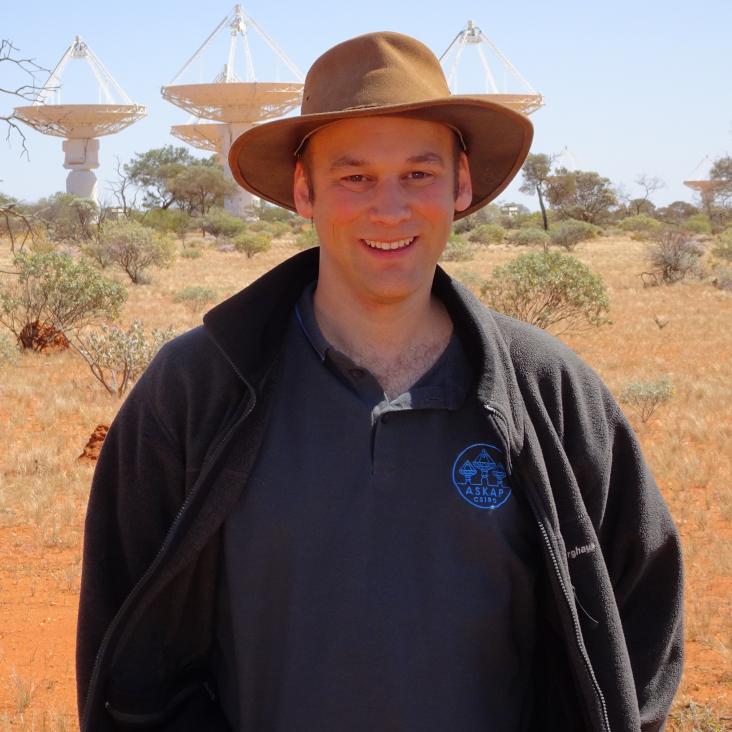An ALMA view of star formation efficiency suppression in early-type galaxies after gas-rich minor mergers
Monthly Notices of the Royal Astronomical Society Oxford University Press (OUP) 476:1 (2018) 122-132
A radio counterpart to a neutron star merger
Science American Association for the Advancement of Science 358:6370 (2017) 1579-1583
Abstract:
Gravitational waves have been detected from a binary neutron star merger event, GW170817. The detection of electromagnetic radiation from the same source has shown that the merger occurred in the outskirts of the galaxy NGC 4993, at a distance of 40 megaparsecs from Earth. We report the detection of a counterpart radio source that appears 16 days after the event, allowing us to diagnose the energetics and environment of the merger. The observed radio emission can be explained by either a collimated ultrarelativistic jet, viewed off-axis, or a cocoon of mildly relativistic ejecta. Within 100 days of the merger, the radio light curves will enable observers to distinguish between these models, and the angular velocity and geometry of the debris will be directly measurable by very long baseline interferometry.Illuminating gravitational waves: A concordant picture of photons from a neutron star merger
Science American Association for the Advancement of Science 358:6370 (2017) 1559-1565
Abstract:
Merging neutron stars offer an excellent laboratory for simultaneously studying strong-field gravity and matter in extreme environments. We establish the physical association of an electromagnetic counterpart (EM170817) with gravitational waves (GW170817) detected from merging neutron stars. By synthesizing a panchromatic data set, we demonstrate that merging neutron stars are a long-sought production site forging heavy elements by r-process nucleosynthesis. The weak gamma rays seen in EM170817 are dissimilar to classical short gamma-ray bursts with ultrarelativistic jets. Instead, we suggest that breakout of a wide-angle, mildly relativistic cocoon engulfing the jet explains the low-luminosity gamma rays, the high-luminosity ultraviolet-optical-infrared, and the delayed radio and x-ray emission. We posit that all neutron star mergers may lead to a wide-angle cocoon breakout, sometimes accompanied by a successful jet and sometimes by a choked jet.Follow up of GW170817 and its electromagnetic counterpart by Australian-led observing programmes
Publications of the Astronomical Society of Australia Cambridge University Press 34 (2017) e069
Abstract:
The discovery of the first electromagnetic counterpart to a gravitational wave signal has generated follow-up observations by over 50 facilities world-wide, ushering in the new era of multi-messenger astronomy. In this paper, we present follow-up observations of the gravitational wave event GW170817 and its electromagnetic counterpart SSS17a/DLT17ck (IAU label AT2017gfo) by 14 Australian telescopes and partner observatories as part of Australian-based and Australian-led research programs. We report early- to late-time multi-wavelength observations, including optical imaging and spectroscopy, mid-infrared imaging, radio imaging, and searches for fast radio bursts. Our optical spectra reveal that the transient source emission cooled from approximately 6 400 K to 2 100 K over a 7-d period and produced no significant optical emission lines. The spectral profiles, cooling rate, and photometric light curves are consistent with the expected outburst and subsequent processes of a binary neutron star merger. Star formation in the host galaxy probably ceased at least a Gyr ago, although there is evidence for a galaxy merger. Binary pulsars with short (100 Myr) decay times are therefore unlikely progenitors, but pulsars like PSR B1534+12 with its 2.7 Gyr coalescence time could produce such a merger. The displacement (~2.2 kpc) of the binary star system from the centre of the main galaxy is not unusual for stars in the host galaxy or stars originating in the merging galaxy, and therefore any constraints on the kick velocity imparted to the progenitor are poor.Multi-messenger observations of a binary neutron star merger
Astrophysical Journal Letters Institute of Physics 848:2 (2017) L12


